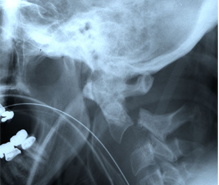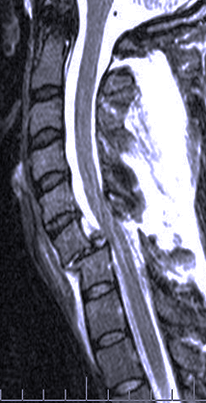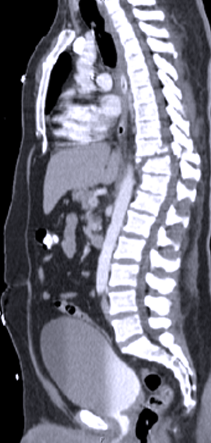
X-ray of a C2 fracture, also known as a Hangman’s fracture and this particular case is a severe one necessitating surgical treatment
Spinal injuries can be serious life threatening problems that cause paralysis requiring complex surgical repair and others are lesser injuries that my only result in transient pain that are treated with a brace or collar while they heal. Fractures can occur in various regions of the spine and must be evaluated by a spine surgeon with experience in these injuries. Some of those complex problems can also now be treated with minimally invasive techniques developed recently that avoid major surgical procedures. Dr Johnson’s experience in all types of spinal fractures dates back the mid 1980’s at UCLA then Cedars Sinai where he was also Director of the Spine Trauma Program. Subsequently he has trained many surgeons throughout the country who now treat spinal fractures on a regular basis.
Publications:

MRI scan of a 30 year old female involved in a head-on car accident and had a C6-7 fracture-dislocation (due to bilateral locked facets) and fortunately did not have a spinal cord injury
Drazin D, Shirzadi S, Jeswani S, Ching H, Rosner J, Rasouli A, Kim TK, Pashmam R, Johnson JP: Direct surgical repair of spondylosis in athletes: indications, techniques, and outcomes. Neurosurg Focus 31 (5):E9, 2011
Ghostine S, Woods K, Vaynman S, Shirzadi A, Scibelli SS, Samudrala S, Johnson JP:Treatment of thoracic vertebral fractures in The Comprehensive Treatment of the Aging Spine: Minimally Invasive and Advanced Techniques. Atlas of Emergency Neurosurgery in joint collaboration with the AANS Publications Committee and the Trauma
Section 2009
Rustamzadeh E, Siddique K, Johnson JP:Fracture-dislocations of the thoraco-lumbar spine. Atlas of Spinal Trauma: Adult and Pediatric. Editors: Kim DH, Ludwig SC, Vaccaro AR., Elsevier Inc., Philadelphia, PA 2007.
Stokes JK, Villavicencio AT, Liu PC, Bray RS, Johnson JP: Posterior atlantoaxial stabilization:
a new alternative to C1-2 transarticular screws.
Neurosurgical Focus 12(1): Article 6, January 2002

This a 36 year old soldier was injured in a helicopter accident and had paralysis from the fracture-dislocation he sustained at T9-10 that required surgery to stabilize this severely unstable fracture and prevent further injury
Johnson JP, Lane JM: Traumatic lumbar
pseudomeningocele occurring with spina bifida occulta: a case report. Journal of Spinal Disorders 11(1):80-83, 1998.